(Continued from Frieze New York part 1)
One thing that also spoke to the elitist, anti-democratic feel of Frieze was the lack of union workers. There were mixed reactions to this--after all, many art writers are outraged by Sotheby's lock-out of its unionized art handlers. It seems patently unfair for entities like Sotheby's that are so rich and profitable to reduce benefits for its workers. But at the same time, unions at convention centers and display halls are just one more monopoly (like Aramark or Freeman), and as such a total pain in the ass to deal with.
The snaking tent is a triumph of design, affording a blessing rare enough alas in museums and almost unheard-of in North American fairs: natural, diffuse, overhead light. (This was perhaps a tad over-augmented the Sunday of my last visit with harsh artificial light to compensate for an overcast start to the day.) The curved layout avoids the oppressions of the grid so that as the viewer moves through the space there is a sense of progress, of arriving at a new bend in the curve. Spaces are neat but individualized and sight lines nicely varied. According to David Nolan of David Nolan Gallery, the organizers managed to “get rid of the politics” that is the art fair norm. The management told him “not one gallery complained about placement.” There is ample space between sections, booths are big, the floor is strictly a uniform, gray wood paneling – rather than the oppressive concrete, cheap carpeting and pretentious cacophony of individual booth flooring solutions that mar the fair going experience at convention centers and armories. And because they had struck out with their own temporary structure at Randall’s Island, Frieze didn’t have to work with the catering contracts and intransigent unions of these venues. This meant invitations to top-notch eateries like The Fat Radish and the late Leo Castelli’s watering hole, Saint Ambrœus, and it meant relaxed, friendly staff. The perceived remoteness of the location and the steep entrance fee of $40 meant an absence of crowds. Exhibitors I spoke to do not regret the selected volume of attendees as it meant a more committed (read “likely to spend”) kind of viewer had a better time of it. ["On an Island in the River – Sunday in Randall’s Park with Frieze" by David Cohen, Artcritical, May 6, 2012]David Cohen doesn't seem to have too much problem with the lack of union workers. Paddy Johnson is less accepting.
While we heard the few dealers who had in-booth lighting were pleased they didn’t have to wait four hours for a union guy to come screw in their lightbulbs, the fair’s ongoing labor dispute with the Carpenters Union stands out. While interviewed for an industry documentary, a press person hovered over me, ready to shut down any conversation that might include the labor dispute. Frieze should be ashamed. ["The Lowdown on Frieze New York" by Paddy Johnson, Art Fag City, May 4, 2012]And Geraldine Visco suggested the location was chosen specifically to avoid unions.
I boarded the M35 bus at 125th Street and Lexington Avenue and arrived at the entrance to Frieze 10 minutes later. I was immediately assaulted by the vision of a giant rat and an assortment of union men standing around protesting the fact that Frieze wasn’t using union labor. In fact, I was told that by a staff member that Frieze specifically chose Randall’s Island so they wouldn’t have to hire union employees. ["Frieze Frame on Randall's Island" by Geraldine Visco, Hyperallergic,May 7, 2012]But I have heard a slightly different story. First of all, apparently Frieze in London is in a tent like this in Regents Park. The number of locations in New York City where one can erect a mile-long tent must necessarily be limited. Also, the problem with having the show in an established convention venue is that you end up dealing with mediocre monopolists who have exclusive contracts with the venue. The union labor at a convention center is just one more crappy monopoly that you are forced to deal with. As someone who has gone to a lot of conventions and dealt with these companies, I can relate.As far as I'm concerned, at a trade show (or an art fair), the union is the same as Aramark which is the same as Freeman--a provider of mediocre service that you are forced as an exhibitor to use. I don't blame Frieze for working around that.
Anyway, let's look at some more art:
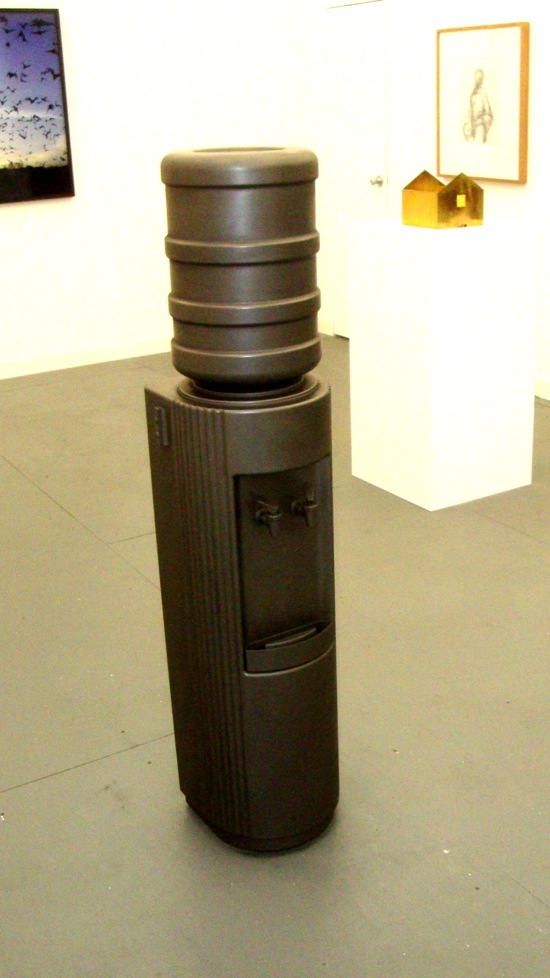
Adam McEwen, Water Cooler, 2012, graphite at art:concept
Adam McEwen's Water Cooler could be used as a giant pencil in a pinch.
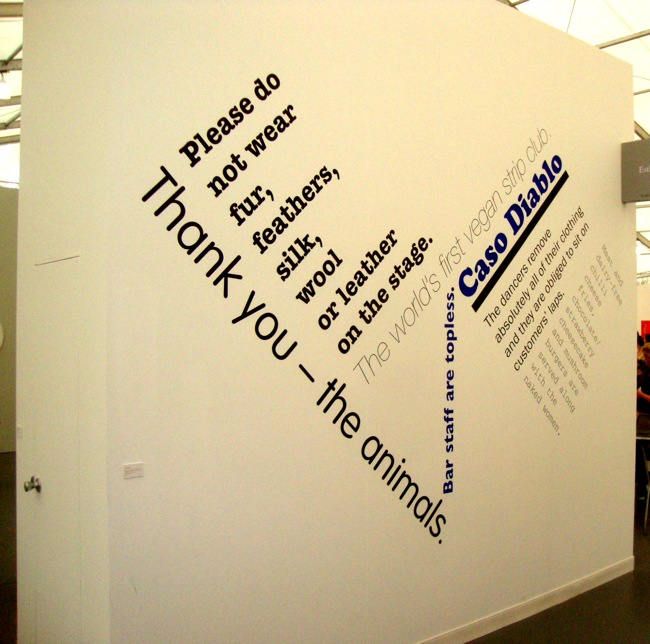
Angela Bulloch, Casa Diablo, 2012 at Esther Schipper
My friend Paul was amused by this piece by Angela Bulloch because, as he put it, he likes it when the politically correct is combined with the politically incorrect. And he added that it would have been even funnier if bicycles were somehow involved. (Vegan strippers who commute via fixed-gear bikes?)
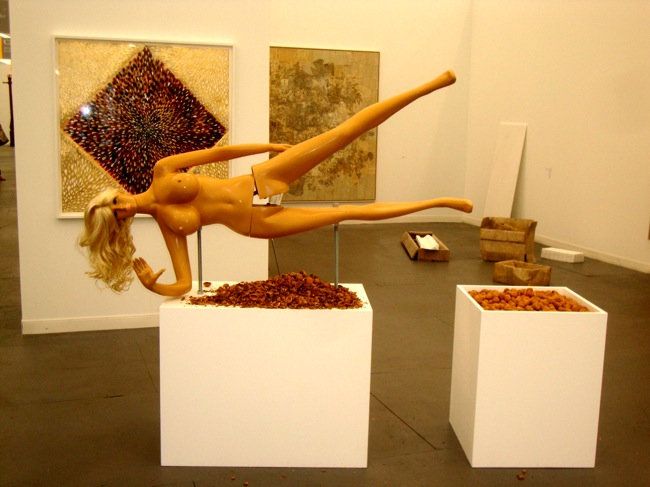
Jennifer Rubell, Lysa I, mixed media, 2012 at Breeder Gallery
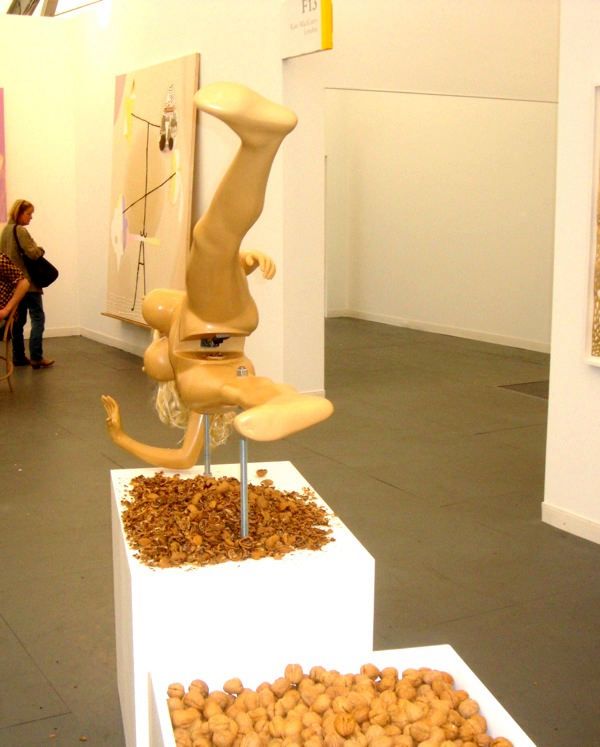
Jennifer Rubell, Lysa I, mixed media, 2012 at Breeder Gallery
Speaking of politically incorrect, this sex-mannequin nutcracker by Jennifer Rubell was astonishingly crass. It belonged at Pulse, which seemed to be full of work like this. This strikes me as one of your "have your cake and eat it" pieces. It is a degrading image of a woman, but that's OK because it's also about sexism and objectification! I'm sorry, but I ain't buying it. It seemed much less a comment about anything than a decadent object for rich people. Plenty of visitors were willing to use the nutcracker--you can see the shells beneath the crotch. I was a little too creeped out to use it, personally.

Amanda Ross, Time Waits for No One, 2011 at Sfeir-Semler
The perfect artwork for all needlepoint/Rolling Stones fans.
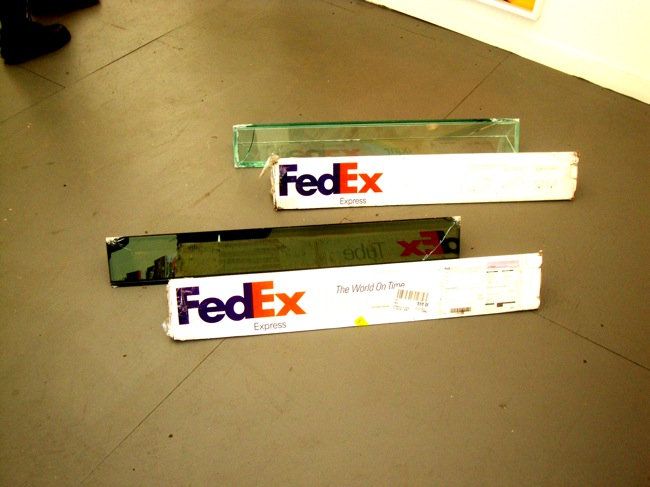
Walead Beshty, Fedex Tube c2005 FEDEX 139752 REV 10/05 SSCC shipping TBD. Los Angeles-city TBD trek# TBD. date TBD. 2011, 2009-, at Regen Projects
If you have ever had to ship posters, you probably used this weird-shaped Fedex box. It's their mailing tube box. What Walead Beshty did was to ship laminated glass designed to fit exactly in the box. The random breakages caused by the handling creates the unique prism-shaped sculpture at the end of the shipping process. But my question is, do you display the box as well, or just the glass? The glass by itself is an intriguing, pretty sculpture. But displayed with the box, it becomes a documentation of a process.

Tom Sachs, Saturn V (painted version), 2011, bronze, plywood base at Galerie Thaddaeus Ropac
Tom Sachs is apparently really into space travel.
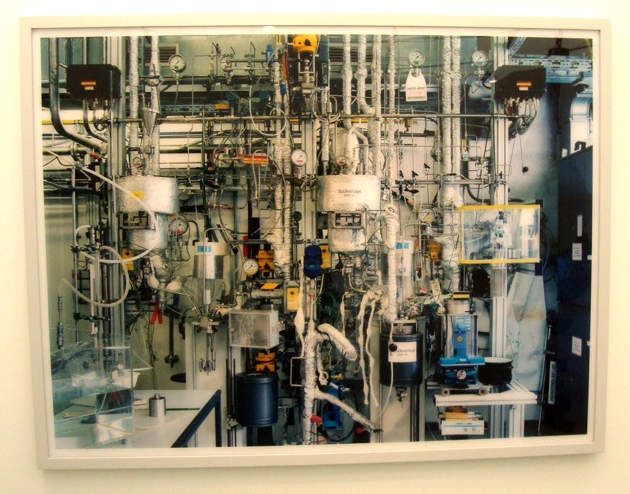
Thomas Struth at Galerie Rüdiger Schöttle

Steven Shearer, Poems, charcoal on rag paper at Modern Art
It seems that Steven Shearer has some stuff to work out.
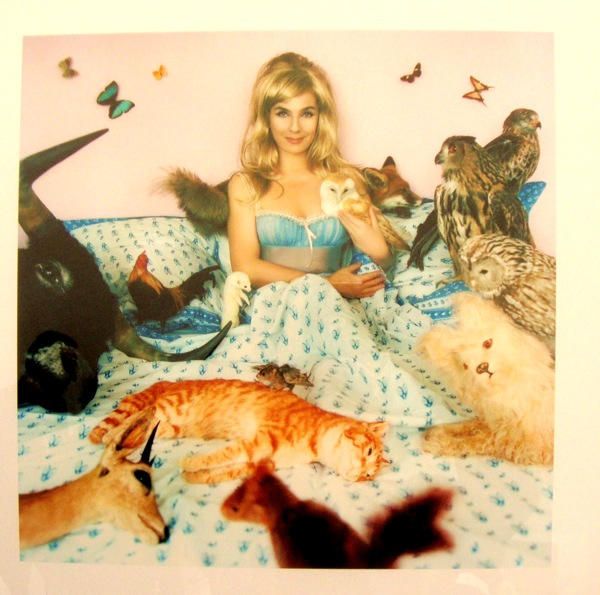
Sophie Calle, "Des journées entières sous le signe du B, du C, du W. BB", 1998 at Galerie Perrotin

Ryan McLaughlin at Lüttgenmeijer
My photo doesn't do it justice, but I thought the paintings of food by Ryan McLaughlin had a real joie de vivre.
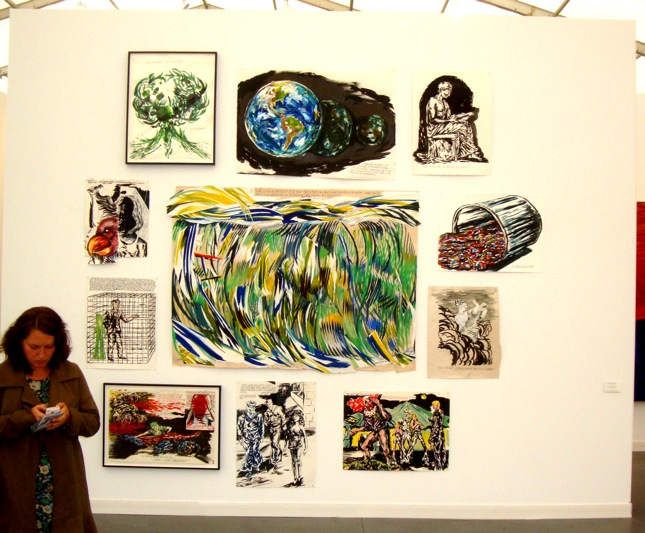
Raymond Pettibon at Regen Projects

Raymond Pettibon at Regen Projects
Along with Sean Landers, Raymond Pettibon held down the "scary clown art" position at the fair.
(Continued in Frieze New York part 3)




No comments:
Post a Comment